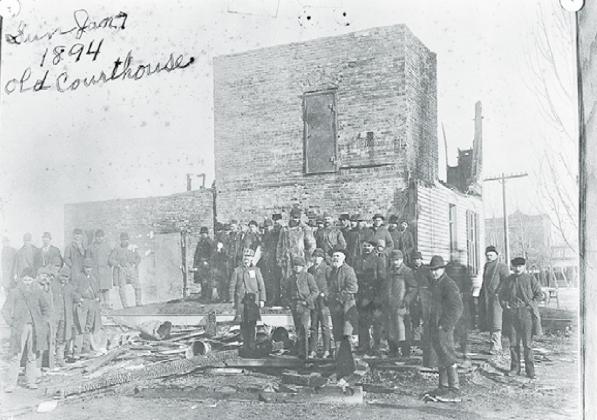Courthouse burns under mysterious circumstances
The Hamilton County Courthouse is home to some of the area’s oldest and most impressive architecture, as well as a wealth of historical prowess and its own mysteries. Recognizing its 125th birthday this year, it might be worth a look back at the iconic structure’s origins and the changes it has undergone over the years.
“Construction of the present Hamilton County Courthouse was started in 1894 and the building was finished in 1895,” reads the introduction the courthouse’s centennial history book, complete with stories written by former Aurora Register editor Hap Fruits from newspaper files complied by John Green, former assistant director of the Plainsman Museum.
“It replaced the county’s second courthouse, located on the same site, that was built in 1877 and burned under suspicious circumstances in January 1894,” the introduction continues. “The effort by Hamilton County officials to solve that mystery is part of the story of the construction of the new courthouse. There was another mystery, too. Did the former county treasurer really defraud the county of funds to cover up some misdeed? Or was his persecution just the politics of the day? His trial also is part of the courthouse story.”
The story of the building that now stands proudly in the center of Aurora’s downtown square begins many years ago, with a report on the courthouse fire in an Aurora newspaper of the day. It unfolded from there over the following several months as the new courthouse was built.
The courthouse burns
“An account of the fire under the headline ‘The Court House Burned’ was in the Jan. 13, 1894 issue of the Hamilton County Register,” Fruits wrote. “Here are a few excerpts: About 15 minutes after 4 o’clock on Sunday morning (Jan. 7), the Hamilton County Court House was discovered to be on fire and in an incredibly short space of time it was burned to the ground.”
According to the article, “Mr. Shipley” the bus driver was the first to see the blaze and gave the alarm to W. J. Threadkell who alarmed the waterworks by means of the telephone. The fire company responded promptly, but had a hard time getting needed water on the flames. This was reportedly the result of a broken hose and the “blowing off of the top of a hydrant by the water pressure.”
Everything, except the fire proof safe, a small amount of wall and woodwork on the south and east corners of the building, was lost.
“The loss which can hardly be estimated as yet will fall very hard upon our people,” the article continues. “The building and contents were insured for $3,500 in the Home of N.Y. and Phenix of Brooklyn. Books that cost $2,000 were burned in the treasurers’ vault, $300 worth of surveyor tools were destroyed, law books belonging to the county to the amount of over $100 were in the judges office, all the stoves and furniture are gone and the treasurer’s books involving, we are told, the loss of the record of delinquent taxes and the condition of the levy for 1893.”
This information was joined by that of speculation revolving the cause of the fire. According to treasurer Carver, his deputy and Sheriff McConaughey, the treasurer’s vault was locked the night of the fire, but first responders found it open upon arrival.
“There seems to be some divergence as to whether there was a fire in the vault when first discovered,” it reads.
A new courthouse
Information gathered from a Jan. 27, 1894 article states that city officials and residents were left with the question of whether or not to rebuild on the spot or to relocate the courthouse to another part of the city. Given Aurora’s size in 1894 -- not that big -- a proposal to build a new courthouse on the “Farley block” in the “western part of town” meant a move of only four blocks.
Though everyone agreed on the fact that the county needed a new courthouse as “promptly as possible” discussion on where and how much commissioners wanted to spend carried on for a while before it was decided.
“The Hamilton County commissioners finally settled on an architect to design the new courthouse in Aurora that would replace the one destroyed by fire in January,” the March 23, 1984 story by Fruits reads. “But signing him up wasn’t going to be easy. Their choice, which, by the way, was not unanimous among the three commissioners, was William Gray. But first, he would have to undergo an investigation. It seems he was the target of what were called ‘some indefinite charges’ that included incompetence.”
Gray’s selection was announced in The Aurora Sun (one of three original Aurora news-papers). But before the county attorney was able to prepare the man’s contract commissioners held a hearing to further investigate these charges themselves. With little evidence, and despite arguments from one commissioner, the county attorney and several other contractors poised to take the job, commissioners found nothing at fault with Gray and finalized his contract.
This is when the debate over the cost of building a new courthouse, and how much the county was willing to spend, really heated up. Eventually the bond issue passed and $60,000 was set aside for the construction of the new building.
“None are more pleased with the result of the election than those having made the fight,” read a May 4, 1894 article. “The perspective of the proposed courthouse is neat and shows a stone building which would probably satisfy the voters. It is believed by many that a house faced with stone will be more satisfactory than one faced with pressed brick and they hope to see the county board insist on such a building believing that it can be had within the appropriation.”
A notice was published in that same week’s paper on behalf of the citizens of Hampton, who pledged a grand total of $20,000 to the construction of the courthouse -- but only on the condition that the county seat (and courthouse) be moved from Aurora to Hampton.
Construction
“The County Commissioners published a notice this week (May 18, 1894) stating that the county will build a courthouse according to plans, specifications and details prepared by architect William Gray of Lincoln and bids are being sought from contractors,” Fruits wrote.
Bidders were required to give a quote for a building with a face of pressed brick, trimmed in Colorado Red Sandstone and terracotta. The deadline for bids was June 27. Around this time commissioners were still in the midst of trying to find out who had burned down the previous courthouse.
“We would soon learn that the former treasurer is indeed a suspect in the fire and the motive was to cover up some misplaced funds,” Fruits said. “Besides the new courthouse making news in future months, so will the trial of Mr. Farney.”
The bid for construction was later awarded to Atkinson Bros. Co. of Colorado Springs, Colo., for a total of $55,777 (though they ended up only paying $55,395) for a pressed brick courthouse -- much different than its frame wood predecessor.
“Just six months after the Hamilton County Courthouse in Aurora was destroyed by fire, construction on the new one was about to begin,” the July 13, 1894 article reads.
Shortly after on July 26 of that year, local brick mason George Daniels delivered the more than 1 millions bricks he had been contracted to make for the building’s construction.
“Ground was broken Monday (July 30, 1894) morning for the new courthouse and several men and teams were put to work to do excavating,” an Aug. 3, 1894 article in the Aurora Republican reads. “We are informed by the contractor that work will be pushed as fast as possible, and that all men and teams that can find a place anywhere will be put to work.”
Sometime between then and Oct. 5 of that year the courthouse’s first janitor was hired in Charley Davis at $45 a month. The courthouse construction was completed on Sept. 14, 1895.
In December of 1895 the district court would hold its first session. Malcolm Swanson and Mrs. Emma Anderson were the first couple married in the new courthouse. The first license was issued to N.B. Carver and Miss Elizabeth Rathgeb of Hampton.
‘Ground was broken Monday morning for the new courthouse and several men and teams were put to work to do excavating. We are informed by the contractor that work will be pushed as fast as possible, and that all men and teams that can find a place anywhere will be put to work.’
Aug. 3, 1894 - Aurora Republican





